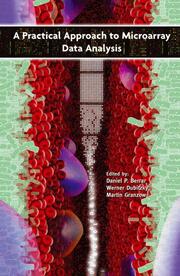A Practical Approach to Microarray Data Analysis von Daniel P Berrar/Werner Dubitzky/Martin Granzow
A Practical Approach to Microarray Data Analysis
ISBN/EAN: 9781475778090
Sprache: Englisch
Umfang: xvi, 368 S.
Einband: kartoniertes Buch
Erschienen am
19.03.2013
Auf Wunschliste
In the past several years, DNA microarray technology has attracted tremendous interest in both the scientific community and in industry. With its ability to simultaneously measure the activity and interactions of thousands of genes, this modern technology promises unprecedented new insights into mechanisms of living systems. Currently, the primary applications of microarrays include gene discovery, disease diagnosis and prognosis, drug discovery (pharmacogenomics), and toxicological research (toxicogenomics). Typical scientific tasks addressed by microarray experiments include the identification of coexpressed genes, discovery of sample or gene groups with similar expression patterns, identification of genes whose expression patterns are highly differentiating with respect to a set of discerned biological entities (e.g., tumor types), and the study of gene activity patterns under various stress conditions (e.g., chemical treatment). More recently, the discovery, modeling, and simulation of regulatory gene networks, and the mapping of expression data to metabolic pathways and chromosome locations have been added to the list of scientific tasks that are being tackled by microarray technology. Each scientific task corresponds to one or more so-called data analysis tasks. Different types of scientific questions require different sets of data analytical techniques. Broadly speaking, there are two classes of elementary data analysis tasks, predictive modeling and pattern-detection. Predictive modeling tasks are concerned with learning a classification or estimation function, whereas pattern-detection methods screen the available data for interesting, previously unknown regularities or relationships.
InhaltsangabeAcknowledgements. Preface. 1. Introduction to Microarray Data Analysis; W. Dubitzky, et al. 2. Data Pre-Processing Issues in Microarray Analysis; N.A. Tinker, et al. 3. Missing Value Estimation; O.G. Troyanskaya, et al. 4. Normalization; N. Morrison, D.C. Hoyle. 5. Singular Value Decomposition and Principal Component Analysis; M.E. Wall, et al. 6. Feature Selection in Microarray Analysis; E.P. Xing. 7. Introduction to Classification in Microarray Experiments; S. Dudoit, J. Fridlyand. 8. Bayesian Network Classifiers for Gene Expression Analysis; B.-T. Zhang, K.-B. Hwang. 9. Classifying Microarray Data Using Support Vector Machines; S. Mukherjee. 10. Weighted Flexible Compound Covariate Method for Classifying Microarray Data; Y. Shyr, K.M. Kim. 11. Classification of Expression Patterns Using Artificial Neural Networks; M. Ringnér, et al. 12. Gene Slection and Sample Classification Using a Genetic Algorithm and k-Nearest Neighbor Method. 13. Clustering Genomic Expression Data: Design and Evaluation Principles; F. Azuaje, N. Bolshakova. 14. Clustering or Automatic Class Discovery: Hierarchical Methods; D.C. Stanford, et al. 15. Discovering Genomic Expression Patterns with Self-Organizing Neural Networks; F. Azuaje. 16. Clustering or Automatic Class Discovery: non-hierarchical, non-SOM; K.Y. Yeung. 17. Correlation and Association Analysis; S.M. Lin, K.F. Johnson. 18. Global Functional Profiling of Gene Expression Data; S. Draghici, S.A. Krawetz. 19.Microarray Software Review; Y.F. Leung, et al. 20. Microarray Analysis as a Process; S. Jensen. Index.






